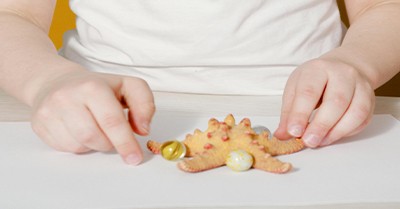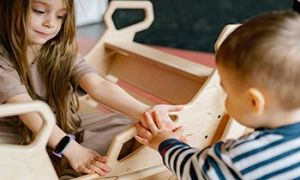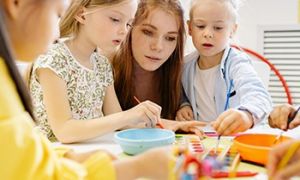Loose parts play is a powerful, open-ended approach that invites children to explore, create, and express themselves using everyday materials. It fosters autonomy, imagination, and problem-solving and can be tailored to your environment and the developmental needs of your children.
Materials: What Counts as Indoor Loose Parts?
Loose parts are anything children can move, manipulate, combine, redesign, or repurpose. Indoors, this can include:
Recycled & Everyday Items
- Bottle caps, cardboard rolls, fabric scraps
- Buttons, beads, paper clips, rubber bands
- Old keys, CDs, corks, lids, straws
Natural Elements (safe for indoor use)
- Smooth stones, shells, dried leaves
- Twigs, seed pods, pinecones
Art & Craft Supplies
- Pom-poms, feathers, sequins
- Yarn, string, pipe cleaners
- Cut-up magazines, textured paper
Sensory & Tactile Items
- Sponges, mesh, bubble wrap
- Textured tiles, silicone molds
Tinkering & Tech Bits
- Disassembled electronics (with safety checks)
- Nuts, bolts, springs, gears
Store materials in baskets, trays, or transparent tubs to encourage self-selection and autonomy.
How to Use Loose Parts Indoors
1. Collage & Composition
Invite children to create abstract or themed collages using loose parts on cardboard or felt mats. Encourage storytelling through placement—e.g., “This is my jungle made of buttons and feathers.”
2. Construction Challenges
Offer a mix of connectors (e.g., straws, clips, string) and building parts (e.g., boxes, tubes, sticks) for children to build towers, bridges, or imaginary machines.
3. Dramatic Play Props
Loose parts become costumes, instruments, or set pieces. A string of beads becomes a royal necklace; a cardboard roll becomes a telescope.
4. Mandala & Pattern Making
Use stones, shells, and beads to create radial patterns or symmetrical designs. This supports mindfulness and fine motor skills.
5. Problem-Solving Stations
Pose challenges like “Can you build something that rolls?” or “Create a creature with three eyes.” Children use loose parts to prototype and test.
6. Documentation & Reflection
Photograph children’s creations and invite them to caption their work using child voice prompts. This builds language, pride, and emotional safety.
Emotional & Educational Benefits
- Autonomy: Children choose how and what to create.
- Creativity: No “right” way to use materials.
- Emotional Safety: Mistakes are part of the process.
- Collaboration: Children co-create and negotiate meaning.
- Fine Motor & Cognitive Development: Sorting, stacking, and problem-solving are embedded.
Tips for Implementation
- Rotate materials regularly to keep interest high.
- Include culturally relevant items (e.g., sari scraps, rangoli stencils).
- Use visual prompts or story starters to inspire play.
- Respect children’s creations—avoid tidying too quickly.
- Document play with photos, child voice captions, and reflection sheets.
Further Reading
Loose Parts Play In Outdoor Areas
Loose Parts Materials For Babies, Toddlers and Preschoolers
Loose Parts: A Guide For Educators
Benefits Of Loose Parts







 As an Educator in Australia, your pay rate falls under the Children’s Services Award 2010. This award states the minimum amount that an employer can
As an Educator in Australia, your pay rate falls under the Children’s Services Award 2010. This award states the minimum amount that an employer can When working as a qualified Early Childhood Teacher (with a university degree) within a service, your rate of pay will come from the Educational Services
When working as a qualified Early Childhood Teacher (with a university degree) within a service, your rate of pay will come from the Educational Services When working as a Diploma Qualified Educator your pay rate is from the Children's Services Award 2010. This Award states your minimum rate of pay
When working as a Diploma Qualified Educator your pay rate is from the Children's Services Award 2010. This Award states your minimum rate of pay When working as a Cert 3 Qualified Educator, your pay rate is from the Children's Services Award 2010. This Award states your minimum rate of
When working as a Cert 3 Qualified Educator, your pay rate is from the Children's Services Award 2010. This Award states your minimum rate of Educational Leaders play a crucial role in their early childhood service by ensuring that the educational program aligns with best practices and supports the holistic
Educational Leaders play a crucial role in their early childhood service by ensuring that the educational program aligns with best practices and supports the holistic In early childhood education and care, ratios are more than a technicality—they are a frontline safeguard. Every child deserves responsive supervision, emotional connection, and developmental
In early childhood education and care, ratios are more than a technicality—they are a frontline safeguard. Every child deserves responsive supervision, emotional connection, and developmental With the new national child safety reforms kicking in on 1 September 2025, early childhood services like yours have a real opportunity to lead the
With the new national child safety reforms kicking in on 1 September 2025, early childhood services like yours have a real opportunity to lead the Here’s a comprehensive Mobile Phone and Smart Watch Policy tailored for early childhood education and care (ECEC) services in Australia, aligned with the latest 2025
Here’s a comprehensive Mobile Phone and Smart Watch Policy tailored for early childhood education and care (ECEC) services in Australia, aligned with the latest 2025 The Sea of Fish Challenge is a national initiative that invites children, educators, families, and communities to create and display fish artworks as a symbol
The Sea of Fish Challenge is a national initiative that invites children, educators, families, and communities to create and display fish artworks as a symbol Across the early childhood education and care sector, educators are sounding the alarm: current staffing ratios are insufficient to deliver safe, meaningful, and developmentally appropriate
Across the early childhood education and care sector, educators are sounding the alarm: current staffing ratios are insufficient to deliver safe, meaningful, and developmentally appropriate


